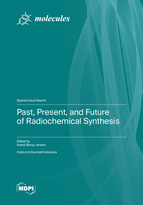Past, Present, and Future of Radiochemical Synthesis
A special issue of Molecules (ISSN 1420-3049). This special issue belongs to the section "Medicinal Chemistry".
Deadline for manuscript submissions: closed (15 July 2020) | Viewed by 45326
Special Issue Editor
Interests: radiochemistry; radiopharmacy; GMP-production; drug degradation; receptor kinetics; analytical methods; chelation; medicinal chemistry
Special Issues, Collections and Topics in MDPI journals
Special Issue Information
Dear Colleagues,
In line with the two previous Special Issues, which I have guest edited for Molecules, I would like this issue to be about radiochemistry and related topics. I came up with a title “Past, Present, and Future of Radiochemical Synthesis”, which I hope will inspire authors.
We are, for example, looking for reviews that focus on the development of theranostics (therapy + diagnosis) for a specific target or a specific disease, or reviews looking into how radiopharmaceuticals in use today have reached this status.
We are also interested in original research papers within the areal of radiochemistry. These could address how a certain radioactive compound has been prepared and why, how a radioactive compound has taken our understanding of a biological system to a different level, how a radiopharmaceutical can be used for treatment, and/or how a radioactive compound has improved our understanding of a certain drug (binding pattern and/or metabolization of the drug).
The purpose of this Special Issue is to host research and review papers on the past, present, and future of radiochemical synthesis.
Dr. Svend Borup Jensen
Guest Editor
Manuscript Submission Information
Manuscripts should be submitted online at www.mdpi.com by registering and logging in to this website. Once you are registered, click here to go to the submission form. Manuscripts can be submitted until the deadline. All submissions that pass pre-check are peer-reviewed. Accepted papers will be published continuously in the journal (as soon as accepted) and will be listed together on the special issue website. Research articles, review articles as well as short communications are invited. For planned papers, a title and short abstract (about 100 words) can be sent to the Editorial Office for announcement on this website.
Submitted manuscripts should not have been published previously, nor be under consideration for publication elsewhere (except conference proceedings papers). All manuscripts are thoroughly refereed through a single-blind peer-review process. A guide for authors and other relevant information for submission of manuscripts is available on the Instructions for Authors page. Molecules is an international peer-reviewed open access semimonthly journal published by MDPI.
Please visit the Instructions for Authors page before submitting a manuscript. The Article Processing Charge (APC) for publication in this open access journal is 2700 CHF (Swiss Francs). Submitted papers should be well formatted and use good English. Authors may use MDPI's English editing service prior to publication or during author revisions.
Keywords
- Radiochemisty
- Radiopharmacy
- PET
- SPECT
- Radioaktiv labeling
- ADME (absorption, distribution, metabolism, and excretion), but only for radioactive compounds
Related Special Issue
- Radiopharmaceuticals in Molecules (24 articles)







